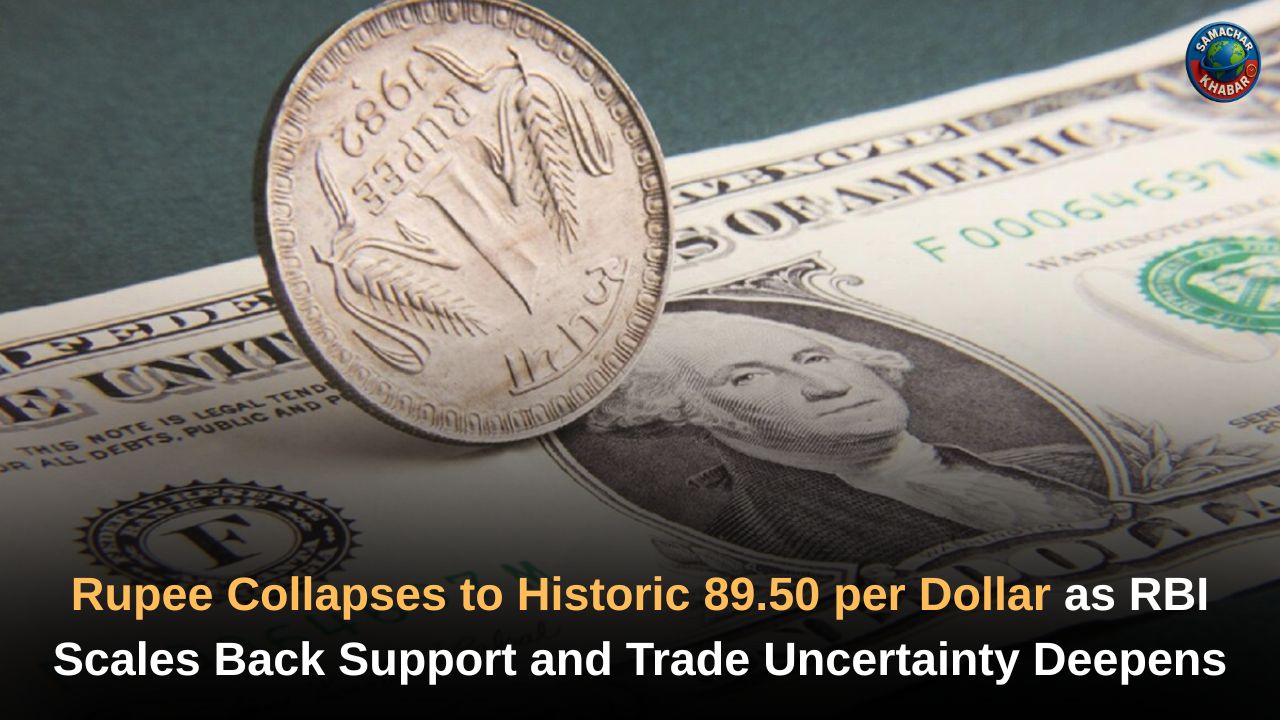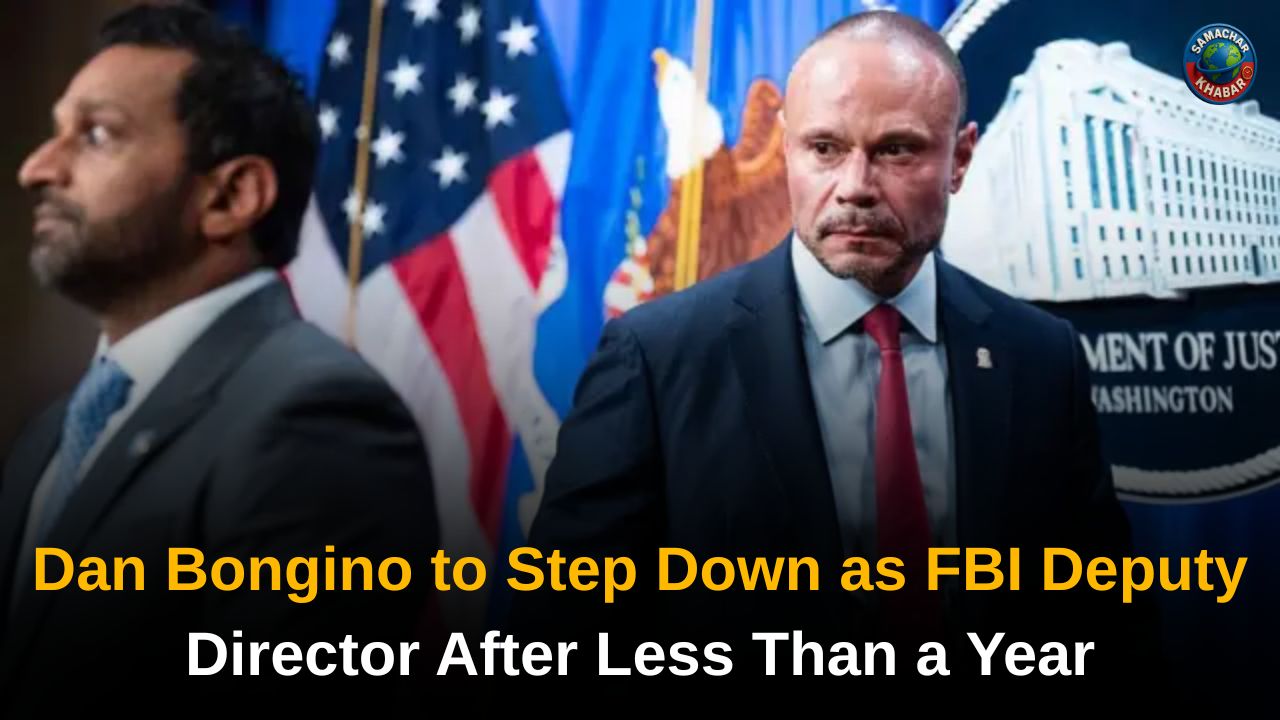The Indian rupee plunged to an unprecedented low on Friday, slipping past the long-defended 88.80 mark and hitting levels near 89.50 against the US dollar. The sudden and sharp slide, driven by fading expectations of a US Federal Reserve rate cut, escalating US–India trade tensions, heavy foreign investor outflows, and a visible reduction in RBI intervention, triggered unusual volatility across the currency and financial markets.
Traders reported large stop-loss activity, a spike in dollar demand, muted exporter participation, and a clear absence of the strong dollar supply that the central bank had been providing in previous weeks.
Key Takeaways: Rupee’s Record Fall and Market Impact Explained
- Rupee hit 89.48–89.54, its weakest level ever, breaching the previously defended 88.80 support.
- Slide driven by US–India trade deal uncertainty, steep US tariffs, and fading Fed rate-cut hopes.
- RBI, which had been actively defending 88.80, appeared to scale back intervention and stepped in only near 89.50.
- India has seen $16.5 billion in FII equity outflows in 2025, making the rupee one of Asia’s weakest currencies this year.
- Reliance Industries halted Russian crude imports due to US deadlines, adding to market discomfort.
- Traders anticipate further RBI action if volatility continues, but pressures remain elevated.
Rupee Freefall Begins After Breaking the 88.80 Line of Defence
For weeks, the Reserve Bank of India had held the 88.80 level as a firm line of defence. Exporters, importers, and currency traders had adjusted positions anticipating that the central bank would not allow a breach. But on Friday, the market was caught off guard.
A trader from a state-run bank said no one expected the RBI to allow 88.80 to break, and once it did, the market saw a gap-up move in USD/INR with very few sellers willing to offer dollars. Volumes surged sharply, and short covering intensified, creating a rapid downward spiral for the rupee.
Dilip Parmar of HDFC Securities described the fall as the biggest single-day percentage drop since May 8, driven by short covering, a delay in the US–India trade deal, and what appeared to be an absence of visible RBI intervention through much of the morning session.
Why the Rupee Crashed: A Cluster of Domestic and Global Pressures
Analysts and traders pointed to a combination of global and domestic triggers:
1. Fading Hopes of a Federal Reserve Rate Cut
A shift in US monetary policy expectations strengthened the dollar globally, weighing on emerging-market currencies.
2. Steep US Tariffs on Indian Exports
Tariffs imposed in late August have added continuing pressure on India’s external sector and investor sentiment.
3. Massive Foreign Investor Outflows
Foreign investors have withdrawn $16.5 billion from Indian equities this year, making the rupee one of the weakest Asian currencies of 2025.
4. US–India Trade Deal Uncertainty
With negotiations delayed, markets anticipate prolonged risks. Traders said the pressure may ease only after a favourable trade agreement is secured.
5. Hedging Demand from Importers
Importers were actively hedging positions, adding to dollar demand.
6. Muted Exporter Activity
Exporters remained largely inactive despite attractive levels, thereby limiting dollar supply.
RBI’s Changing Role: From Active Defender to Selective Intervener
While the RBI has been visibly supporting the rupee in recent weeks, Friday showed a different pattern. According to traders, the central bank seemed to pull back from its aggressive defence strategy, allowing the currency to drift lower before intervening near 89.50.
Dhiraj Nim of ANZ said the RBI appeared to be “relenting to a market that has been short INR for quite some time,” but a positive trade deal could materially strengthen the currency ahead.
Also Read: SBI Signals Support as Government Prepares Major PSU Bank Merger Overhaul
Mitul Kotecha of Barclays noted that traders were surprised the RBI did not step in earlier, especially when the rupee broke past 89. The absence of strong intervention signalled a strategic shift and added to the market’s uncertainty.
Corporate & Market Developments Adding to the Pressure
Alongside currency volatility, major corporate and policy developments intensified concerns:
- Reliance Industries confirmed it had halted Russian oil imports, complying with US deadlines for private refiners to stop sourcing from Rosneft and Lukoil.
- Stock markets remained under pressure, with Sensex and Nifty trading lower as risk sentiment deteriorated.
- Crypto markets also saw declines, adding to broader global risk-off behaviour.
- Market expert Sharmila Joshi said current market movements reflect a cycle of rising on positive news and fizzling when conditions turn uncertain.
Economic Data Fails to Provide Support
New government data showed that India’s eight core sectors recorded flat year-on-year growth in October. Increases in fertiliser, steel, and refinery products were offset by declines in coal and electricity generation, adding to investors’ cautious outlook.
Traders expect continued volatility as markets watch crude oil trends, global macro cues, FII flows, and progress in the US–India trade negotiations.
Inner Stability Through the Teachings of Saint Rampal Ji Maharaj
In times of economic uncertainty and market volatility, spiritual clarity becomes equally important for individuals and society. Saint Rampal Ji Maharaj’s unique spiritual teachings emphasise inner stability, detachment from material fluctuations, and reliance on true devotion for long-term peace. His knowledge highlights that external circumstances—whether financial, social, or global—will continue to shift, but a spiritually grounded life helps people face uncertainty with calmness, discipline, and clear understanding.
What This Currency Shock Means for the Road Ahead
Friday’s record-breaking fall signals a pivotal moment for the rupee. With global markets in a risk-off mode, US–India trade negotiations unresolved, and investors exiting emerging markets, the currency faces sustained headwinds. While the RBI is likely to intensify interventions if excessive volatility continues, much of the burden now rests on global conditions and the outcome of upcoming bilateral trade discussions.
A favourable trade deal could ease pressure significantly, while continued uncertainty may keep the rupee vulnerable near its historic lows. For now, the currency market remains on edge, waiting for clearer signals from policymakers and global economic trends.
FAQs on Indian Rupee Hitting a Record Low Near 89.50 Against the US Dollar
1. Why did the Indian rupee fall to a record low near 89.50?
The rupee fell due to weak risk sentiment, US–India trade uncertainty, fading Fed rate-cut hopes, US tariffs, and reduced RBI intervention.
2. Did the RBI intervene when the rupee hit record lows?
Traders said the RBI scaled back earlier defence of 88.80 and likely intervened only near 89.50 to reduce excessive volatility.
3. How did foreign investor flows affect the rupee’s decline?
Heavy FII outflows of $16.5 billion from Indian equities in 2025 weakened the rupee and made it one of Asia’s worst performers.
4. What role did the US–India trade deal uncertainty play in the rupee’s fall?
Delayed negotiations heightened market anxiety and strengthened dollar demand, adding sustained pressure on the Indian currency.
5. What triggered the sharp volatility after the 88.80 level broke?
The break caused stop-loss triggers, short covering, high importer demand and muted exporter activity, resulting in a rapid rupee slide.

















